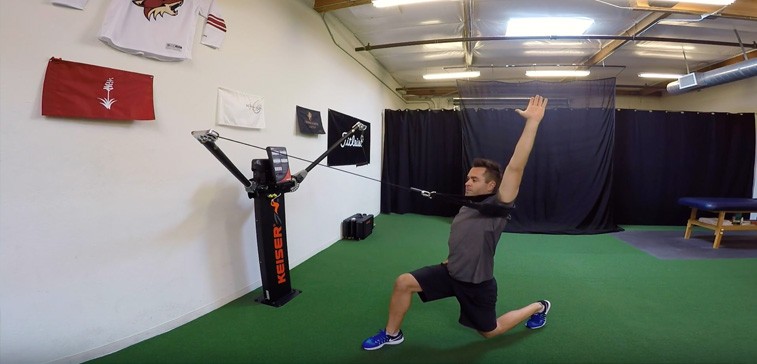
Blog Breakdown:
- Prolonged sitting and standing with poor postural alignment increases a person’s risk of upper crossed syndrome, rounded shoulders, and tight pectoral muscles.
- Fortunately, there are exercises that can help loosen tight shoulder muscles, increase flexibility, and reduce upper back discomfort.
- In this blog, CEO of Golfstretch Adam Swanson demonstrates an exercise called an assisted lunge with shoulder flexion to help with these issues.
The exercise I’m about to share with you may help activate the muscles in your upper back, ultimately increasing shoulder mobility and range-of-motion. Sounds pretty great for your golf game, right? It gets better. For those of you who work at a desk all day, this movement can also help reduce some of the discomfort in your upper back by strengthening your shoulder, neck, and pectoral muscles.
Today, it seems to be a common occurrence for people to develop back problems such as upper crossed syndrome, rounded shoulders, and upper and lower back pain from various occupations (i.e. desk jobs, retail work, etc.). This is unfortunate, but there are things that can be done to combat these health problems. Performing a number of back strengthening exercises can help reinforce weak muscle groups, eventually reducing pain and discomfort. For the purpose of this blog, I will be demonstrating an assisted lunge with shoulder flexion while explaining how the exercise benefits upper body issues.
This exercise activates the muscles of the upper body to help with shoulder flexion, which is an important component in your golf swing. The other benefit to this exercise is its incorporation of the lower body. When you lunge backward during this stretch, you’re activating your core, glutes, quads, and hamstrings simultaneously. Ultimately, people who perform this exercise receive a full-body workout when it’s performed with the right intensity.
Assisted Lunge With Shoulder Flexion
For this exercise, you will need access to a functional trainer, or you will need to possess F & T lateral bands or heavy-duty resistance bands. In this video, I utilize a functional trainer. As you can see, I start by wrapping the loop-side of the trainer over my shoulder with my upper arm held in an upward fashion. Notice how my arm is locked in a straight position. Your arm should be high above the shoulder blade, but in line with the rest of your body, as demonstrated in the video.
Take a few steps backward to create space between you and the functional trainer. When you’re ready, keep your right foot planted firmly on the ground and step your left foot backward into a lunge position. While you perform this maneuver, make sure your arm is held in that straight, upward position. You’ll want to repeat this motion about 9 more times for a total of 10 reps.
Next, keep your left foot planted firmly on the ground before stepping your right foot backward into a lunge position. Repeat this motion another 9 times for a total of 10 reps. Feel free to increase the weight in the functional trainer or increase your rep frequency if you want a bit of a challenge.
If you have any questions or concerns, please do not hesitate to call me to schedule an appointment. I would be happy to work with you on your golf and fitness goals. Until then, review the video below and let me know what you think of the assisted lunge with shoulder flexion exercise!
Golfstretch is a sports performance and rehabilitation center located in Scottsdale, Arizona. Utilizing a combination of therapies, the team at Golfstretch helps clients achieve their health and fitness goals. To learn more about golf fitness, stretch therapy, corrective exercise, and more, call 480-269-1119 to schedule a consultation today! We look forward to hearing from you!
The advice and information contained in this article is for educational purposes only and is not intended to replace or counter a physician’s advice or judgment. Please always consult your physician before taking any advice learned here or in any other educational medical material.
